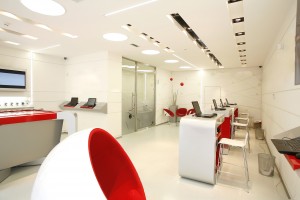How Smart Workplace Design can Make Your Firm a Talent Magnet

It’s easy to be overawed by employers like Google, and conclude that Google’s new age, super seductive design inspiration is out of the reach of mere mortals. That may be true to some degree, but it’s also a dereliction of duty to treat the modern knowledge working office setup process as little more than a how-many-sardines-in-a-tin exercise, or a morbidly functional how-many-desks-in-a-class-room style exercise. This approach is no longer sufficient for housing a multifaceted workforce that needs to collaborate, learn, socialize and also get their heads down and work.
And if you do adopt this retrograde approach, you can expect to see employee engagement, brand equity and profit that are 14 percentage points lower than those with effective work environments, according to the Gensler study. You really can’t afford to be giving any of these advantages away in the competitive talent and operational climate we currently inhabit.
So, what can be done?
With some quite simple changes or considerations, you can make an office that fulfills the four needs of the modern worker : collaborate, learn, socialize and focus.
For starters, give people think space or failing that, think time. This study of workplace productivity shows that 86 percent of employees prefer to work alone to hit peak productivity, with noisy co-workers and interruptions from impromptu meetings and co-workers being the biggest productivity killers. So, I am not saying that everyone should get corner offices or you need to create creativity sapping, cubicle rammed workplaces, but at least create some dedicated, quiet working spaces where staff can go and work on projects requiring focus as and when needed. If you can’t do space, at least try ‘think time’ like they have tried at Intel, which is several hours a week where employees block out ‘think time’ where they shouldn’t respond to emails or attend meetings. (This Intel think-time apparently yielded a patent application!)
Of course, staff members need to socialize and collaborate, particularly amongst the millennial generation found this Johnson Controls study. While there is no question that open-plan offices are under attack at the moment, employees need to be able to interact with each other to capture and develop ideas, bond and build relationships.
The answer to this conundrum of private versus collaborative space is to move from a fixed environment to a more flexible environment, enabling employees to work as they wish, when they wish, to suit their lifestyle or the job they do. There should be plenty of open, collaborative team spaces; suiting bigger and small gatherings; more or less informal gatherings; and there should also be plenty of private work spaces where employees have the flexibility to move around as required.
Where possible, try and incorporate cloud-based working protocols, collaborative technologies, BYOD and home working programs so employees can work seamlessly between office and home. Of course, there’s nothing wrong with a few bells and whistles like at Google, but it’s not necessary. The essentials of talent-centered workplace design require at the most basic level designing a flexible space where employees have the option to socialize, collaborate and work privately in a flexible and seamless manner.

